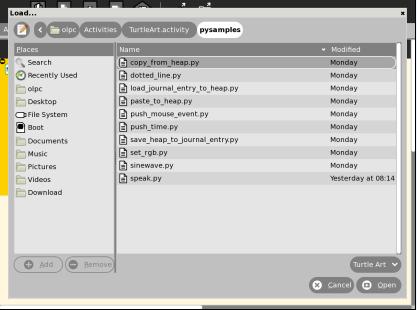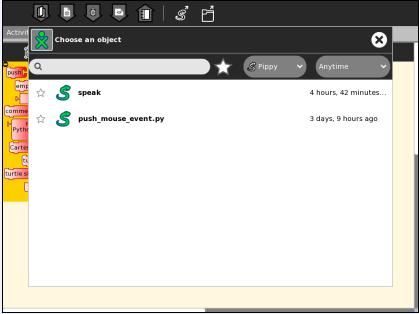Activities/Turtle Art/Help: Difference between revisions
| Line 186: | Line 186: | ||
==Credits== | ==Credits== | ||
* Walter Bender and Raúl Gutiérrez Segalés maintain the code (with some occasional help from Simon Schampijer) | |||
* Alan Jhonn Aguiar Schwyn and the Butia Team have provided great feedback and many patches. | |||
* Especially helpful feedback from Tony Forster, Guzmán Trinidad, and Bill Kerr | |||
* Brian Silverman is the first author of Turtle Art | |||
Revision as of 08:24, 21 April 2012
About Turtle Art
Turtle Art, also known as Turtle Blocks, is an activity with a Logo-inspired graphical "turtle" that draws colorful art based on snap-together visual programming elements. Its "low floor" provides an easy entry point for beginners. It also has "high ceiling" programming, graphics, mathematics, and Computer Science features which will challenge the more adventurous student.
Where to get Turtle Art
http://activities.sugarlabs.org/en-US/sugar/addon/4027
Note: There are two inter-compatible programs: Turtle Art and Turtle Blocks. Turtle Art, which closely parallels the Java version of Turtle Art maintained by Brian Silverman, offers a small subset of the functionality of Turtle Blocks. Turtle Blocks is the version included in the Sugar distribution. Sugar users probably want to use Turtle Blocks rather than Turtle Art. (Also see Turtle Confusion, a collection of programming challenges designed by Barry Newell.)
Using Turtle Art
Start by clicking on (or dragging) blocks from the Turtle palette. Use multiple blocks to create drawings; as the turtle moves under your control, colorful lines are drawn.
You add blocks to your program by clicking on or dragging them from the palette to the main area. You can delete a block by dragging it back onto the palette. Click anywhere on a "stack" of blocks to start executing that stack or by clicking in the Rabbit (fast) , Turtle (slow) or Bug (debug) buttons ![]() on the Project Toolbar.
on the Project Toolbar.
The basics
-
Basic turtle graphics: 'forward', 'back', 'arc', and 'right' blocks
-
The 'set color' block affects pen trails, fill and text
-
'set pen size' block
-
'pen up' and 'pen down'
Drawing shapes
-
Use the 'repeat' block to draw shapes
-
This can be generalised to n sided polygons, n is stored in 'box 1'
-
Use 'start fill' and 'end fill' to draw filled shapes
-
There's no limit
Displaying things
-
Use 'print' to display in the print window
-
'show' block used to display at the turtle
-
'show' an image or video
-
'show' the camera output
-
'show' plays sounds as well
-
'print' and 'show' can display text or numbers including results of calculations
-
'print' or 'show' mixed text and numbers, using '+'
-
Text to speech. Load the Python block with the inbuilt sample code speak.py
Boxes, Stacks and the Heap
(aka variables, subroutines and the stack)
-
Named variables: store a variable in 'box'
-
Named 'stacks' of blocks can be reused
-
Collapse a 'stack' of blocks to save space
-
Store data in the first in last out heap using 'push' and 'pop'
-
Box names (and stack names) can be boxes, in this case 10 boxes are created. This is a powerful programming feature. A one dimensional array of variables has effectively been created.
Mathematics
-
Math operators including + - * / mod sqrt
-
Logical operations: flow control blocks accept >, <, =, and, not, or as input
-
Make pie charts [1]
-
Cartesian and polar coordinate grids
-
Centimeter coordinate grid (XO only)
Keyboard, mouse and sensor input
-
Reading the keyboard
-
Converting the keyboard output to a string
-
Entering a multi digit number, exits with the number in 'box 1', [[2]]
-
Load the Python block with the sample code push_mouse_event.py to read mouse events
-
Read the microphone
-
Read sensors plugged into the microphone socket [3]
The Toolbars
<Activity-specific descriptions>
Learning with Turtle Art
Tony Forster and Mokurai have created a number of Turtle Art Tutorials on a wide range of math, programming, art, and Computer Science topics. There is also a substantial literature of educational materials using the Logo programming language, from which Turtle Art and Turtle Blocks derive. The Exploring with Logo series from MIT Press is particularly recommended for showing how far beyond simple graphics Logo can go. Mokurai recommends starting with his first three, specifically designed for helping beginners of all ages, starting with the preliterate in preschool.
- You be the Turtle without the computer.
- Mathematics and art, an introduction to TA.
- Counting
Extending Turtle Art
There are versions of Turtle Art in several programming languages and environments, including Logo, Python, Smalltalk, and others. Turtle Art can export programs in Logo, as explained below. There are programmable blocks in Turtle Art which make it possible to include any Python program within the Turtle Art world. The simplest case is a single function call used in a graphing program, but there is no inherent limit on what capabilities of Python one can add to TA.
Exporting to Berkeley Logo
Turtle Art can export its projects to Berkeley Logo (using either View Source or the Save as Logo button on the Project Toolbar) You can download the Berkeley Logo activity here.
-
A Turtle Art project
-
The UCB Logo version (see "Internals" below)
Logo code generated from your project is viewable in the View Source panel in some versions of Turtle Art, but as of v100, the Turtle Art project itself is shown instead.
-
Turtle Art code
-
View Source menu
-
Logo code
Note: The Save-as-Logo button saves to the Journal as "logosession.lg". UCB Logo does not yet access the Journal directly, so it is necessary to copy the project out of the Journal using the "copy-from-journal" command in the Terminal Activity and then accessing the project using the File menu within the UCB Logo Activity.
copy-from-journal logosession.lg
Alternatively, you can open the logosession in 'Write', copy the Logo code to the clipboard, and then paste it into the UCB Logo Activity.
Python Blocks in Turtle Art
There are two ways to create Python blocks: by loading sample code provided with Turtle Art or by loading Python code the your Journal.
loading sample code
A number of individual sample programs are provided. Clicking on the Load Python Block button on the Load/Save Toolbar ![]() will invoke a file-selector dialog. Select the sample that you want and it will be both copied to the Journal and loaded into a Python block.
will invoke a file-selector dialog. Select the sample that you want and it will be both copied to the Journal and loaded into a Python block.
loading code from the Journal
Clicking on a Python block ![]() that has been dragged onto the canvas from the Extras palette will invoke an object-selector dialog.
that has been dragged onto the canvas from the Extras palette will invoke an object-selector dialog.
Select the Python code that that you want and that code will be loaded into the selected block.
You can't run a Python block by clicking on it, as that opens the object selector; instead attach the block to another one and click elsewhere on the stack you have created.
Which ever way you create them, multiple Python blocks can have different code loaded in them.
Modifying Turtle Art
Turtle Art is under the MIT license. You are free to use it and learn with it. You are also encourage to modify it to suit your needs or just for a further opportunity to learn.
Much of the motivation behind the Version 83 refactoring of the code was to make it easier for you to make changes. Most changes can be confined to two modules: taconstants.py and talogo.py. The former defines the blocks and palettes; the latter defines what code is executed by a block.
Note: As of Version 106, there is also support for plugins. If you can use the plugin mechanism to add support for additional devices, e.g., Arduino, or for making modifications such as are described below without making changes to the standard code base. (The advantage to the latter is that your changes will remain intact even after you upgrade to a newer version.)
The tabasics.py file contains the constants that by-in-large determine the behavior of Turtle Art. Notably, the block palettes are defined below. If you want to add a new block to Turtle Art, you could simply add a block of code to that file or to turtle_block_plugin.py, which contains additional blocks. (Even better, write your own plugin!!)
Adding a new palette is simply a matter of:
palette = make_palette('mypalette', # the name of your palette
colors=["#00FF00", "#00A000"],
help_string=_('Palette of my custom commands'))
For example, if we want to add a new turtle command, 'uturn', we'd use the add_block method in the Palette class.
palette.add_block('uturn', # the name of your block
style='basic-style', # the block style
label=_('u turn'), # the label for the block
prim_name='uturn', # code reference (see below)
help_string=_('turns the turtle 180 degrees'))
Next, you need to define what your block will do. def_prim takes 3 arguments: the primitive name, the number of arguments—0 in this case—and the function to call—in this case, the canvas.seth function to set the heading.
self.tw.lc.def_prim('uturn', 0,
lambda self: self.tw.canvas.seth(self.tw.canvas.heading + 180))
That's it. When you next run Turtle Art, you will have a 'uturn' block on the 'mypalette' palette.
You will have to create icons for the palette-selector buttons. These are kept in the icons subdirectory. You need two icons: mypaletteoff.svg and mypaletteon.svg, where 'mypalette' is the same string as the entry you used in instantiating the Palette class. Note that the icons should be the same size (55x55) as the others. (This is the default icon size for Sugar toolbars.)
Where to report problems
Please file bug reports here.
Credits
- Walter Bender and Raúl Gutiérrez Segalés maintain the code (with some occasional help from Simon Schampijer)
- Alan Jhonn Aguiar Schwyn and the Butia Team have provided great feedback and many patches.
- Especially helpful feedback from Tony Forster, Guzmán Trinidad, and Bill Kerr
- Brian Silverman is the first author of Turtle Art

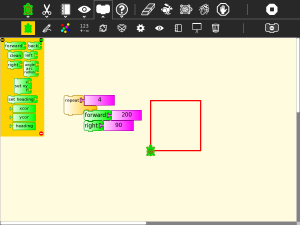



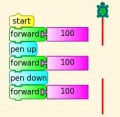





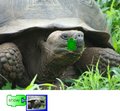











![Make pie charts [1]](/images/thumb/7/7e/Pie2.png/120px-Pie2.png)





![Entering a multi digit number, exits with the number in 'box 1', [[2]]](/images/thumb/8/8a/Entertermnumber.jpg/120px-Entertermnumber.jpg.png)


![Read sensors plugged into the microphone socket [3]](/images/thumb/a/a0/Resistance.jpg/120px-Resistance.jpg)





